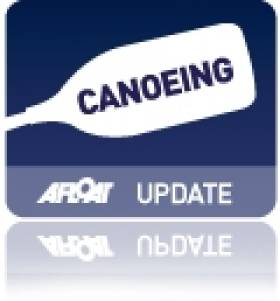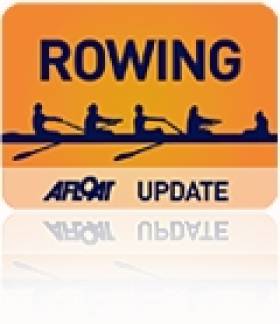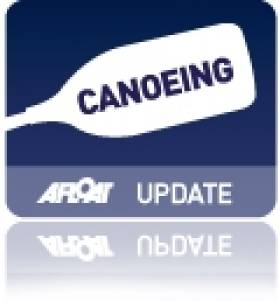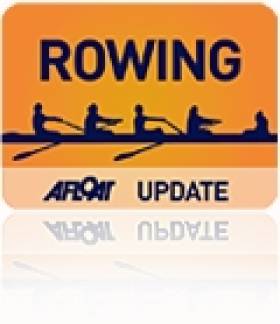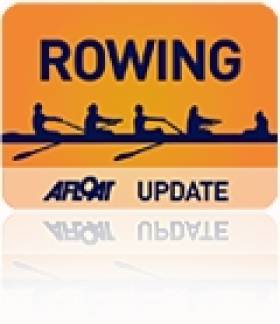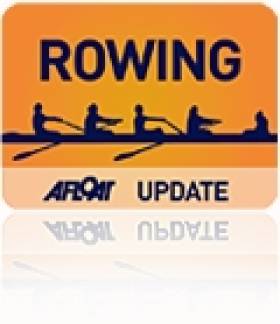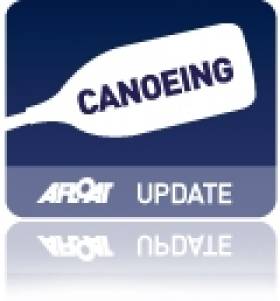Displaying items by tag: World Championships
Hendrick Twins Place Fourth in World in Brazil
#CANOEING: Noel and Robert Hendrick narrowly missed a podium finish at the Junior and Under-23 Canoe Slalom World Championships in Brazil. The twin brothers, competing in a Junior C2 (Canadian canoe), finished fourth behind French, Czech and German pairings. The Hendricks compete for Ribbontail Canoe Club in Enfield in County Meath. Three Ireland competitors exited at the semi-final stage: Jake Cochrane (C1, Under-23), Aisling Conlan (K1, Under-23) and Robert Hendrick (C1 Junior). The Hendrick brothers are set to compete at the European Junior and Under-23 Canoe Slalom Championships in Poland next August.
ICF Canoe Slalom Junior and Under-23 World Championships, Foz do Iguassu, Brazil (Selected Results) – C2 Men, Junior: 1 France 104.25 seconds, 2 Czech Republic 101.64, 3 Germany 105.55; 4 Ireland (N Hendrick, R Hendrick) 109.91.
Conlan Competes in Heat of World Canoeing Championships
#CANOEING: Aisling Conlan finished 47th in her heat of the K1 (racing kayak) at the Canoe Slalom World Championships in Deep Creek in Maryland in the United States today. The Ireland competitor needed to finish in the top 30 to qualify for the semi-finals. Maialen Chourraut of Spain was the fastest in the heats with a time of 111.45 seconds.
Canoe Slalom World Championships, Deep Creek, Maryland, United States - Day Two (Selected Results; Irish interest)
Women
K1 – Heats (Top 30 Qualify for Semi-Finals): 1 Spain (M Chourraut) 111.45; 47 Ireland (A Conlan) 136.20.
Hendrick (16) Given Taste of World Championship Fare
#CANOEING: Robert Hendrick finished 46th in his heat at the Canoe Slalom World Championships in Deep Creek in the United States today. The top 30 qualified for the semi-finals. The 16-year-old C1 (Canadian canoe) paddler had two touches on his first run and four on his second. Alexander Slafkovsky of Slovakia qualified in top position.
Canoe Slalom World Championships, Deep Creek, Maryland, United States (Selected Results, Irish interest)
Men
C1 Heats (Top 30 qualify for the semi-finals): 46 R Hendrick 134.24.
K1 Heats (Top 40 qualify for semi-finals): 53 S Curtis 114.54; 60 P Hynes 124.61.
.
Dilleen and Kennedy Take Eighth at World Rowing Championships
#ROWING: Ireland’s Lisa Dilleen and Leonora Kennedy finished second in the B Final of the women’s pair at the World Rowing Championships in Amsterdam today, placing them eighth overall. Russia’s Liana Gorgodze and Elizaveta Tikhanova, the second slowest of the crews in the semi-finals, took this race by storm. They led all the way down the course despite constant attempts to head them by Ireland, the one crew which mounted a consistent challenge.
World Rowing Championships, Day Seven (Irish interest, selected results)
Women
Pair – B Final (Places 7 to 13): 1 Russia (L Gorgodze, E Tikhanova) 7:06.08, 2 Ireland (L Kennedy, L Dilleen) 7:09.20, 3 Serbia 7:10.61, 4 Canada 7:12.15, 5 Ukraine 7:18.40, 6 Czech Republic 7:19.72.
B Final Place for Jezierksi at Canoe Sprint World Championships
#CANOEING: Andrzej Jezierski finished sixth in his semi-final of the men’s C1 200m at the Canoe Sprint World Championships and will compete in tomorrow’s B Final in Moscow. Peter Egan and Simas Dobrovolskis were seventh in their semi-final of the men’s K1 200m and will go to the C Final. Jenny Egan made her exit from the K1 200m, as she finished eighth in her semi-final, and finished 11th in the women’s 5,000 metres. Jenny Burke placed 4th in the B final of the K1 1,000m, 13th overall.
Canoe Sprint World Championships, Day Four (Irish interest, selected results)
Men
K2 200m – Semi-Final: 7 P Egan, S Dobrovolskis 34.004.
C1 200m – Semi-Final (First Three to A Final; next Three to B Final; rest out): 1 Lithuania 38.320; 6 A Jezierski 39.638.
Women
K1 – B Final (Places 10 to 18): 4 J Burke 3:05.18.
K1 200 – Semi-Final: 8 J Egan 43.097.
K1 5,000 – Final: 1 Britain 23 mins, 10.957 secs; 11 J Egan 24:08.510
Big Ireland Team for World Rowing Championships
#ROWING: The Ireland team for the World Rowing Championships has been named. A team of 14 athletes in seven boats have been selected for the event, which will be held in Amsterdam from August 24th to 31st.
Crews have been based at the National Rowing Centre, where they have been on training and undergoing extensive testing since the World Cup regattas at Aiguebelette in France and Lucerne in Switzerland.
Ireland Team for World Rowing Championships, Amsterdam, August 24th to 31st
Men:
Lightweight Pair: Niall Kenny (UCD BC), Mark O’Donovan (UCD BC)
Lightweight Single Scull (ML1x): Paul O’Donovan (UCD BC)
Women
Four: Barbara O’Brien (NUIG BC), Aifric Keogh (NUIG BC), Emily Tormey (NUIG BC) and Marie O’Neill (Cork BC)
Pair: Lisa Dilleen (Gráinne Mhaol RC) and Leonora Kennedy (Portora BC)
Double Scull: Monika Dukarska (Killorglin RC) and Helen Walshe (Three Castles RC)
Lightweight Double Scull: Denise Walsh (Skibbereen RC) and Claire Lambe (Old Collegians BC)
Single Scull: Sanita Puspure (Old Collegians BC)
#ROWING: Paul O’Donovan won his heat of the lightweight single sculls at the World Under-23 Rowing Championships at Varese in Italy today. Britain’s Sam Mottram held the lead in the middle stages of the race, but O’Donovan passed him and won, with Brazil and Japan taking the other qualifying places for the quarter-finals.
The Ireland four of Richie Bennett, Kevin Neville, Fionán McQuillan-Tolan and Rob O’Callaghan finished fifth in their heat and will compete in a repechage tomorrow. The Irish could not find a way into contention for the top-three spot they needed. Italy won from Croatia and the United States. Belarus took fourth.
World Under-23 Championships, Varese, Italy. Day One (Selected Results; Irish interest)
Men
Four – Heat One (First Three to A/B Semi-Finals): 1 Italy 6:00.06, 2 Croatia 6:02.31, 3 United States 6:05.38; 4 Belarus 6:07.95, 5 Ireland (R Bennett, K Neville, F McQuillan-Tolan, R O’Callaghan) 6:22.36.
Lightweight Single Sculls (First Four to Quarter-Finals): 1 Ireland (P O’Donovan) 7:08.58, 2 Britain 7:11.14, 3 Brazil 7:19.02, Japan 7:20.05; 5 Portugal 7:22.59.
Canoeist Liam Jegou Takes World Championship Silver
#CANOEING: Ireland junior canoeist Liam Jegou took a silver medal today at the Canoe Slalom Under-23 and Junior World Championships in Sydney, Australia. On a difficult course in Penrith, only Florian Breuer of Germany was faster in the C1 (canoe single) than the Irishman. Both men took one touch, Jegou’s on the fourth gate. Roman Malyshev of Russia was third and Britain’s Samuel Ibbotson fourth.
“It’s great, I am really happy,” Jegou said. He had come close to a podium finish in the last two years, finishing sixth last year and fourth in 2012.
Canoe Slalom World Under-23 and Junior Championships, Penrith, Sydney (Irish interest):
C1 Men – Semi-Final (10 qualify): 1 Britain (S Ibbotson) 109.47; 6 Ireland (L Jegou) 112.11 (2.64 behind). Final: 1 Germany (F Breuer) 104.31, 2 Ireland (L Jegou) 107.61, 3 Russia (R Malyshev) 108.54.
Ireland Rowing Trials May Be Cut Short
#ROWING: The Ireland trials on Newry Canal this weekend may be altered because of the forecast of bad weather. Time trials are scheduled for both days over five kilometres, but the distance on Sunday might be cut to 2.5 km. The hope is to use the more sheltered part of the course.
Meanwhile, the Cork Head of the River is now set to be held on March 8th. The interest in the Erne Head of the River on March 1st is impressive, with 77 crews entered.
Ireland Canoeists Lose Time on Portages at World Championships
#CanoeMarathon2013: Ireland’s Jenny Egan and Peter Egan finished 15th and 19th respectively at the Canoe Marathon World Championships at Lake Bagsværd, Denmark, today. Jenny Egan started promisingly but was knocked back by her performances on the portages.
Peter Egan was generally faster on his portages on his paddle, but did lose control of his boat on one and lost time.
Last year, in Rome, Peter Egan finished 17th and Jenny Egan 16th.
Canoe Marathon World Championships, Lake Bagsværd, Denmark (Irish Interest, Selected Results)
Men, K1 (30.1 km): 1 H McGregor (South Africa) 2 hourse 10 mins 34 seconds; 19 P Egan (Ireland) 2:15.26.
Women, K (25.8 km) 1: R Csay (Hungary) 2:01.26; 15 J Egan (Ireland) 2:09.23.



























